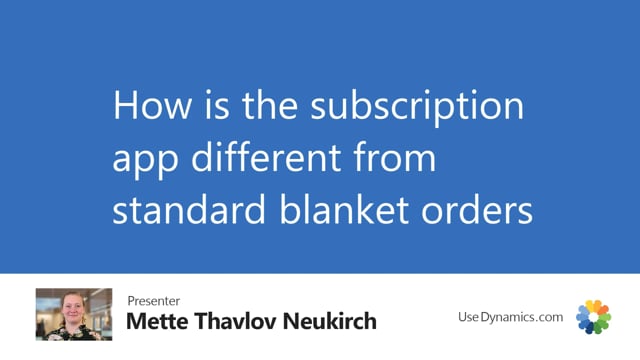
The Subscription Management app is actually built on a standard functionality called blanket sales orders.
A blanket sales order is made when we make an agreement with our customer, for example, to deliver 100 units of a specific item over the course of a year or half a year, in whichever period makes sense in the market we’re in. So for example, here, the customer has agreed to buy 100 pieces, but he will control when he withdraws those items. So he might buy 50 in the beginning, then 5, then wait a bit, buy 20, and then the last 25 on the last sales order. And these frameworks are a good idea if we do demand planning, because then this agreement will be part of our planning, and the system will keep track of the withdrawals, and the system will keep track on withdrawals on the blanket order, and keep track of the remaining amounts. We always have that in our demand planning.
The Subscription app uses subscription orders, and we have made an extension where we add more fields to the blanket order. And the things we have added means that we can focus on recurring invoicing. We don’t focus on the agreed quantity, but we focus on recurring invoices of a license or a membership or similar items. So in the Subscription app, we shift the focus away from a certain quantity and focus more on invoicing, for example, here, 50 licenses every month. And that could be a license to Business Central that your partner invoiced to you.
The general idea is that we invoice the same lines each time on the order, and of course, we can still control end dates and so forth, and we can also control the interval of invoicing. So if it’s monthly or yearly or quarterly invoicing, and the system will keep track of that. So the general difference between the two paradigms with blanket orders and subscription orders is that the blanket orders focus on these withdrawals, which are generated from the customer. So we generate a new sales order each time they do a withdrawal, but they’re in control of when it should be within the given period.
In the Subscription app, we actually put the system in charge of the frequency because the system keeps track of the recurrence period. So in both cases, there’s an underlying agreement with the customer, but the reason for creating these orders are different. And of course, on the subscription order, you can do changes. So if we use that example of Business Central licenses, if you have extra users, so in the last quarter here, you had 60 users, then of course, you can make that adjustment in the system. And also, if it was a downgrade to 40, we can, of course, handle that. So as I mentioned, in both cases, there’s an underlying agreement with the customer, but the reason for invoicing is different, and probably also the items you’re selling.

